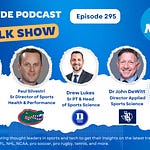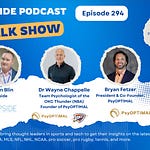Today we have the honor of interviewing Martin O'Reilly, CEO of Output sports, a leading performance company using one sensor including VBT and jump tracking.
Output Sports offers a portable, single-sensor system that allows teams to capture a wide range of performance data, including strength, power, speed, mobility, and balance, all with a single device. This simplicity makes Output particularly attractive for teams that want to collect actionable data quickly and efficiently without the complexity or cost of larger lab-based systems. The platform’s versatility allows practitioners to monitor multiple aspects of an athlete’s development across the full training cycle — from performance testing to return-to-play assessments — while providing immediate feedback that can be shared with both coaches and athletes in real-time.
You can watch the video interview below by clicking on the Youtube link. You can also listen to the audio interview by clicking on the link at the top of the page:
Here is below their mobile app along with their dashboard.
Picture: Output Sports’ dashboard and app.
Here is a video explaining its one sensor:
Picture: Output Sports’ One sensor (Left) and app (Right)
Here is a picture of the dashboard:
Customers / partners: Professional sports teams in rugby, soccer and basketball.
Here is a video testimonial from England Football using Output Sports:
Here is a video testimonial from Spellman performance using Output Sports:
📝Show Notes: Through this interview, we touched on his background, his company and product, the benefits for teams to use their product and platform. We also talked about his competitive advantage, business model, and his plans for the next 12 months.
You can read the full transcript of the podcast interview with Martin located at the top of this blog post.
Here are the best quotes from the interview with Martin:
Q1: Your journey into sports technology is quite unique. Can you share a bit about your background and what inspired you to start Output Sports?
“One of the main things about Output — and really what makes our founding story unique — is that we are a university spinout from University College Dublin. I have three co-founders who all come from very different disciplinary backgrounds. My background is in sports engineering, and my PhD was specifically focused on machine learning of sensor signals. My co-founder is a physiotherapist who has worked directly in elite sport and clinical settings, so he really understands what practitioners need on the ground. And our third co-founder, Julian, comes from a theoretical physics background and was working on banking APIs before we convinced him that sports technology is more fun and impactful! The real beauty was that we had years of interdisciplinary research together starting back in 2013. We were based in the university right up until early 2020, which allowed us to collect around 10 terabytes of proprietary sensor data — a huge foundation for what became our commercial product. Having access to labs, elite teams on campus, and cross-functional experts — from data analytics, engineers, UX, to practitioners — gave us an ideal sandbox to go from research to applied product development.”
Q2: For those unfamiliar, what is Output Sports and what core problem are you solving for performance practitioners and athletes?
“At Output Sports, our mission has always been to make elite-level sports science simple and scalable. Traditionally, high-end biomechanics or performance data was locked inside expensive labs, accessible only to top-tier programs with massive budgets. We wanted to democratize that — to give coaches, physios, and practitioners access to the same level of precision without the burden of expensive, complex setups. Our core product is a single wearable sensor paired with an app that allows you to assess and monitor over 300 different performance metrics — everything from velocity-based training, jump analysis, reactive strength index, mobility, balance, stability, to more niche variables like angular velocity. Initially, we solved the problem of fragmented, time-consuming athlete monitoring. But as we evolved, we also started addressing the ‘so what?’ problem — giving practitioners not just data, but meaningful, actionable insights that help inform day-to-day coaching decisions like fatigue management, exercise prescription, and readiness assessments.”
Q3: The simplicity and portability of your single-sensor system are quite disruptive. Can you walk us through how Output works and what sets it apart?
“One framework I often use to describe where we sit is the ‘value-burden matrix,’ an idea from one of our advisory board members, Jo Cook. On one axis, you have how valuable and accurate the data is; on the other, how burdensome it is to collect, analyze, and implement that data. Traditional lab systems — force plates, motion capture, etc. — are extremely valuable but come with huge costs in terms of time, setup, and money. On the flip side, you have consumer wearables — super easy to use, low burden, but often lacking the precision needed for serious performance applications. Our unique proposition is that we sit at the intersection of high-value, actionable data with minimal burden. With just one sensor and one app, you can collect highly accurate data across multiple key performance domains, implement it instantly in any environment — weight room, field, rehab setting — and get real-time feedback. Portability, scalability, and reliability together make us very distinct.”
Q4: What does your customer base look like today — are you seeing more traction in elite sports, colleges, or private training?
“Our client base today spans over 1,000 organizations, and what’s quite unique is how evenly it splits across different sectors. In Europe, a significant portion is weighted toward elite professional sport — particularly soccer — where we serve teams across multiple leagues and divisions. But in the U.S., while we do have great flagship teams in each of the major leagues, we actually see even stronger traction at the collegiate, high school, and private training facility levels. The U.S. has a very strong private performance ecosystem that doesn’t exist in quite the same way in Europe. Overall, it’s almost a perfect split — roughly 50% in Europe and 50% in North America — with an even balance across elite sport, educational institutions, and private training providers.”
Q5: How are you thinking about expansion? What's on the roadmap for the next 12–18 months?
“We’ve really only just begun to tap into the full market potential. Geographically, we’re staying focused on North America and Europe while also exploring partnerships in other regions. But from a product perspective, the next big frontier is automation and data-driven insights. Right now, we’re capturing over 10 to 12 million reps of exercise data every month, which gives us an incredibly rich dataset. We’ve recently started heavily investing in AI and data science — hiring an AI-first product manager and additional algorithm developers — with the goal of delivering more sophisticated recommendations, training adjustments, and even predictive insights that assist both coaches and athletes directly. In parallel, we’re also exploring adjacent markets like the high-end fitness space, where we believe we can provide very robust strength, power, and movement assessments that complement existing wearables like Garmin or WHOOP. Ultimately, while we started as a hardware-first company, we increasingly see ourselves evolving into a software and data company with hardware as an enabler.”
Q6: Do you see Output playing a bigger role in the integrated data ecosystem alongside AMS, GPS, force plates, etc.?
“Absolutely, we see the growing need for integration across the entire athlete data ecosystem. But we’re very clear on our role — we specialize in strength, power, movement, and speed. That’s our lane, and we aim to do it better than anyone else. Rather than trying to become an all-encompassing AMS system, our philosophy is to make it as easy as possible for our highly accurate data to integrate into broader ecosystems that include GPS, force plates, heart rate monitors, and other emerging tools. We don’t want to become a services company or an AMS vendor; we want to remain a product company focused on generating top-tier data that can slot into whatever integrated system an organization uses. Every team’s needs are different, so we want to empower them with the most reliable strength and movement data possible.”
Q7. Does your software adapt to the specificity of each sports?
“Right now, we allow coaches to customize the system to fit the specific needs of their sport. So within a multi-sport organization — let’s say a university with basketball, Olympic sports, and American football — each sport can build its own dashboards, determine what metrics matter most to track, and set up corresponding workouts or protocols based on those measurements. We give teams the flexibility to structure Output in a way that’s meaningful for their environment.
Beyond that, because we have a growing user base across different sports, we’re starting to see broader trends emerge in the data. For example, we can analyze which strength and power characteristics are associated with faster baseball pitchers or more powerful golf swings. That opens the door for us to eventually provide more automated, sport-specific recommendations — not just at the sport level, but also for specific positions, age groups, and even developmental stages.
As our dataset continues to grow, we’ll be able to stratify those insights and deliver even more tailored recommendations that reflect the unique demands of each sport and position. That’s one of the most exciting parts about having Output deployed at scale — the ability to move from general performance tracking to highly specific, data-driven personalization across different athletic populations.”
Q8: What are your plans for the next 12 months?
“Although we now have over a thousand clients, we’re really just scratching the surface of how big the sports performance market can be. Geographically, our main focus will continue to be North America and Europe. We feel like we’re over the initial product-market fit hump, but there’s still a long way to go to scale significantly within these markets.
From a product development standpoint, we’re investing heavily in building data-driven insights and recommendations. We’ve started hiring specifically for this — we recently brought on an AI-first product manager and two new data science hires for our algorithms team. The goal is to move from just capturing and visualizing data to actually generating intelligent, automated insights for coaches and athletes.
On top of that, while we continue to focus on elite sport, universities, and private training, we’re also starting to explore adjacent markets. For example, we see strong potential in the high-end fitness space — working with gym chains and fitness communities — where people may already be using wearables like Garmin or WHOOP but don’t yet have access to robust strength, power, and movement data like we can provide.
So overall, over the next 12 to 18 months, it’s about expanding geographically, building out the software insights layer, and exploring how we can serve adjacent markets beyond traditional elite sports.”
You may also like:















